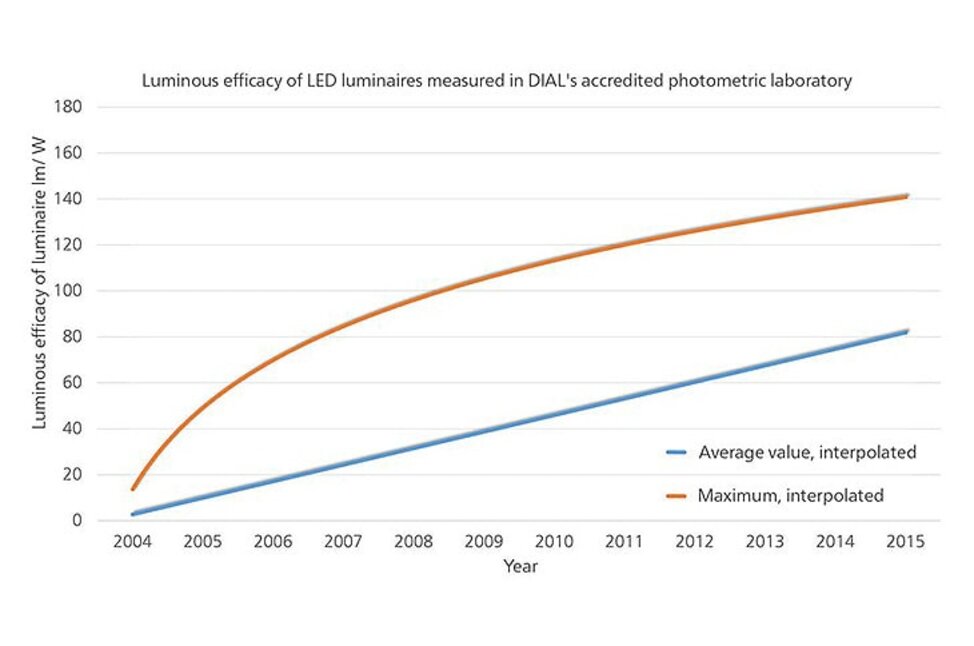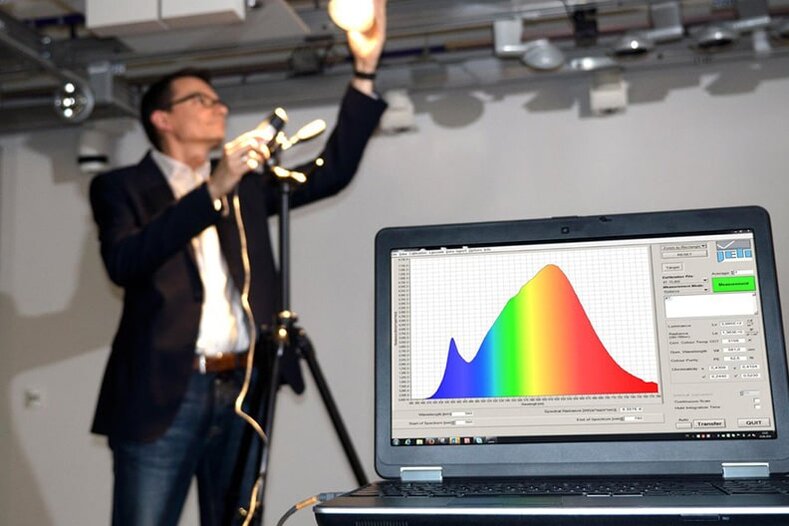The efficiency of lamps has increased considerably in recent years with the use of white LEDs in the field of architectural lighting. Retailers claim that we can expect a gigantic leap forward in luminous efficacy. Such claims cannot be taken seriously.
What does luminous efficacy depend on and how efficient can a white LED actually be? Manufacturers have been competing with each other in recent years with regard to the luminous efficacy of their LED products. However, no attention has been paid to agreeing on a uniform definition of luminous efficacy and operating conditions. Often we find interpretations which are not comprehensible to the planner or designer.
DIAL has mathematically determined the theoretical maximum luminous efficacy of various spectra.
Theoretical maximum luminous efficacy of white LEDs
There are about 7 million receptors in the retina of the human eye: red, green and blue receptors. These perceive colour and are called cones. However, most of them (approx. 60 %) are green receptors. Therefore humans perceive the light colour green as much brighter than red and blue although the physical radiant power is the same.
For the human eye adapted to brightness the maximum relative spectral sensitivity is at a wavelength of 555 nm. The highest perception of brightness experienced by the human eye is generated with green light on the 555 nm wavelength. The greatest luminous efficacy which can theoretically be achieved at 555 nm is, altogether, 683 lm/W. In this context the expert refers to the photometric radiation equivalent Km. However, in practice this value cannot be reached, since, if this were so, it would mean that 1 W of physical radiant power can be converted loss-free into visible light.
Of course, monochromatic green light is not suitable for most lighting purposes even it were the most efficient. The planner likes to use white light with different colour temperatures and optimal colour rendering quality. But simply filling the spectral distribution with further wavelengths in the visible field (380–780 nm) will lead to a drop in the theoretical maximum luminous efficacy.
Of course, monochromatic green light is not suitable for most lighting purposes even it were the most efficient. The planner likes to use white light with different colour temperatures and optimal colour rendering quality. But simply filling the spectral distribution with further wavelengths in the visible field (380–780 nm) will lead to a drop in the theoretical maximum luminous efficacy.
The dependency of luminous efficacy on the spectrum
The following table shows the theoretical maximum luminous efficacy of different spectra as determined mathematically by DIAL:

As well as LEDs with different colour temperatures, there are several examples of temperature radiation and gas discharge. The system efficiency and the luminous flux of the lamp or module of the products in this table were measured in DIAL's own accredited photometric laboratory. The system luminous efficacy results from this. On the basis of the relative luminous sensitivity curve for photopic vision V (λ), the theoretical maximum luminous efficacy was calculated for each spectrum. From the table you can see that the typical spectrum of a warm white LED achieves a theoretical module luminous efficacy of approx. 320 lm/W. However, since the assumption is that there is loss-free conversion of physical radiated power into the wavelengths of the spectrum, then the actual realisable module luminous efficacy is much smaller. In future it may be possible to achieve system luminous efficacy in the range of 200–250 lm/W.
In addition, the overview shows energy conversion efficiency of the lamps examined. The energy conversion efficiency describes how much of the power is converted into visible light. In this respect efficient LEDs are clearly well ahead of conventional lamps. While energy conversion efficiency of incandescent lamps, for example, is between 10 % and 20 %, very efficient LEDs at present achieve values between 40 % and 50 %. Nevertheless, this is still only 40 – 50 %, so 50 % to 60 % of the power is lost as heat.
These figures should not, however, hide the fact that, at present, there are many LEDs on the market which have a much lower system luminous efficacy. Here the energy conversion efficiency is accordingly bad.
Goodbye to the idea of huge advances in luminous efficacy
In the coming years there is not likely to be an increase in the achievable luminous efficacy comparable to what happened in the first years after white LEDs went into serial production. The curve of the maximum luminous efficacy of newly developed products is slowly levelling off.
The average luminous efficacy of LED luminaires will certainly continue to improve since there are luminaires on the market with a luminous efficacy of 50 – 70 lm/W which can still be optimized. This fact is shown clearly in the measurements which DIAL has carried out in its accredited laboratory in the last few years.

There is no question that the LED is an efficient light source. Nevertheless, even the LED is subject to physical limits when it comes to luminous efficacy. The theoretical maximum luminous efficacy always depends on the desired spectrum. Big advances cannot be expected nowadays.
Claims such as „In a few years white LEDs will achieve a luminous efficacy of 500 lm/W!” are quite simply wrong because this is physically just not possible.
A note for planners: Look carefully and always use your common sense.

